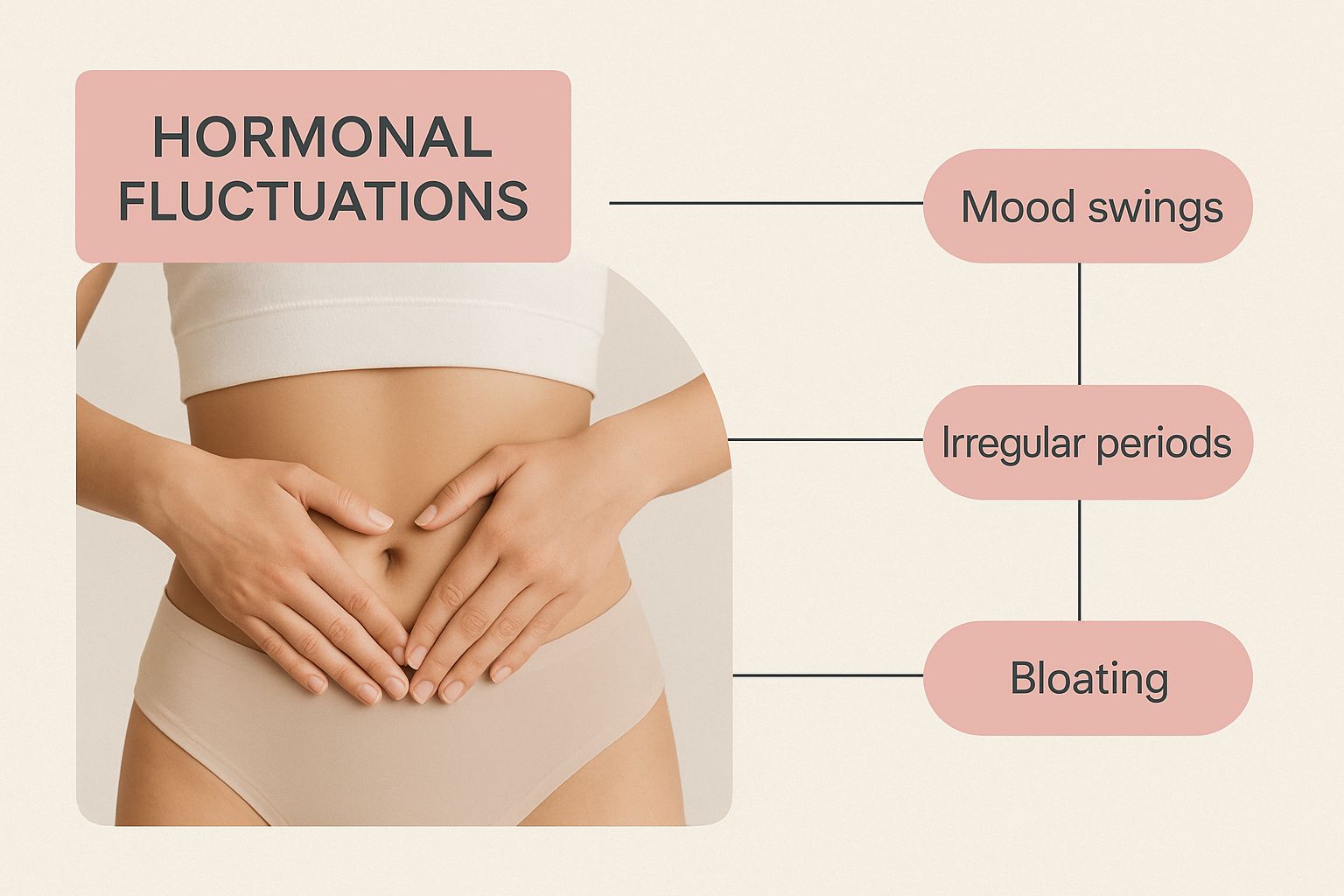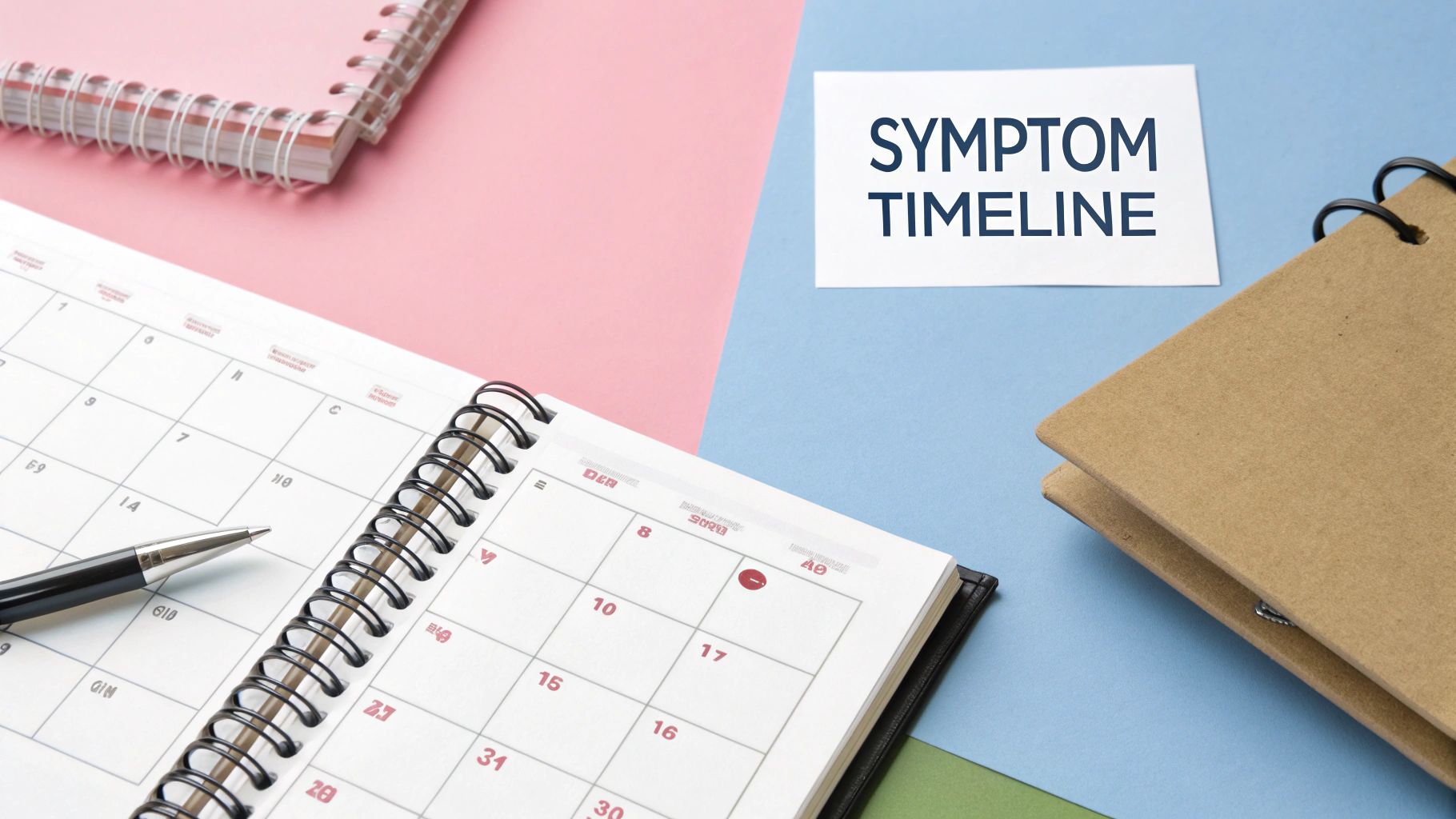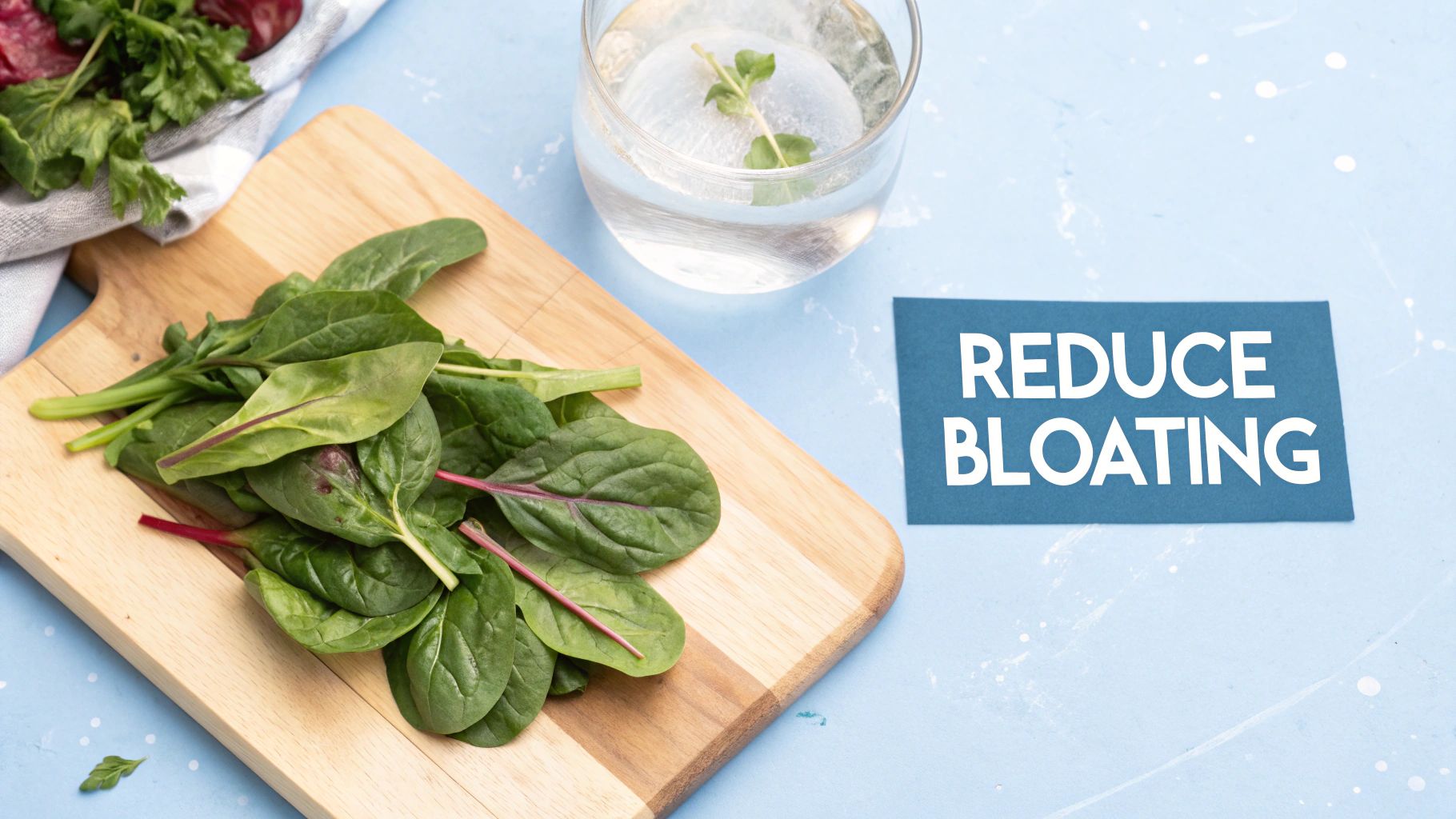
Ovulation and Bloating: Your Guide to Mid-Cycle Relief
Share
Feeling a bit puffy and uncomfortable halfway through your cycle? You’re not imagining it. Bloating during ovulation is an incredibly common experience, and it's usually thanks to a surge in hormones—particularly oestrogen—which encourages your body to retain more water. It’s all part of the natural monthly rhythm as your body prepares for a potential pregnancy.
Why Am I Bloated During Ovulation?
That tight, full feeling in your abdomen that seems to show up like clockwork mid-cycle is a familiar story for many of us. And while it can be frustrating, understanding the 'why' behind it is the first step toward managing it with confidence. It all comes down to the fascinating hormonal dance happening inside your body.
Your Hormones Take the Lead
Think of your menstrual cycle as a finely tuned orchestra. Around ovulation, the hormone oestrogen plays the lead violin, reaching its peak to signal the release of an egg. This oestrogen surge also tells your body to hold onto more salt and water, which leads directly to that uncomfortable, bloated feeling.
This is a completely normal biological process. Essentially, your body is just creating a hospitable environment, in case.
Ovulation bloating is a temporary and direct response to hormonal fluctuations. It’s a sign that your body is progressing through its natural cycle, not a sign that you’ve done anything wrong with your diet or routine.
What to Expect in This Guide
Navigating cycle-related symptoms can feel isolating, but you're definitely not alone in this. Throughout this guide, we'll explore not just the science but also practical, everyday strategies to help you find relief.
We’ll cover:
- The specific roles hormones play in causing that puffy feeling.
- How to track your cycle to anticipate and prepare for symptoms.
- Simple diet and lifestyle tips to help you feel your best.
- When bloating might be a signal to chat with your doctor.
We'll also touch on broader topics like common troubles during menstruation and the importance of period equity here in Aotearoa New Zealand. Our goal is to give you the knowledge to feel empowered and totally in tune with your body's rhythm.
The Hormonal Dance That Causes Bloating
To figure out why you get bloated around ovulation, it helps to see your menstrual cycle as a kind of hormonal dance. It can definitely feel frustrating, but that mid-cycle puffiness is really just a physical sign of all the incredible things happening inside your body as it follows its natural rhythm.
The main choreographer in this dance? Oestrogen. Leading up to ovulation, your oestrogen levels climb, hitting a peak to signal your ovary that it’s time to release an egg. That surge is the number one trigger for water retention.
Oestrogen Takes Centre Stage
When oestrogen levels are high, your body has a tendency to hold onto more salt. And since water always follows salt, this hormonal shift directly causes your tissues to retain more fluid than usual. The result is that familiar feeling of fullness and tightness in your belly.
This infographic gives a simple snapshot of how these hormonal ups and downs can affect your body.

As you can see, the link between hormonal shifts and physical symptoms like bloating is direct and very, very real for a lot of us.
The Role of Luteinising Hormone
Right after oestrogen peaks, another key player makes its entrance: luteinising hormone (LH). A rapid surge in LH is the final cue that tells the follicle in your ovary to rupture and release the mature egg. And that whole event? That’s ovulation.
While oestrogen is the main culprit behind the water retention, the entire hormonal cascade—including LH—contributes to the changes you feel. These hormones don't just act on your reproductive organs; they have a ripple effect throughout your whole system, influencing everything from your mood to your digestion.
It's helpful to remember that ovulation bloating is your body's response to a healthy, functioning cycle. It's a temporary side effect of the very hormones that make reproduction possible.
In Aotearoa New Zealand, bloating linked to ovulation is a common and well-documented experience. This hormonal shift causes the body to retain water through complex interactions that also involve other hormones like the antidiuretic hormone (ADH), all contributing to that noticeable puffiness.
From Ovulation to the Luteal Phase
Once the egg is released, your body shifts into the second half of its cycle, known as the luteal phase. Now, the hormone progesterone starts to rise. Progesterone has a knack for slowing down your digestive system, which can sometimes prolong or even add to the feeling of being bloated.
This mix of hormonal activity is why ovulation bloating can feel like it hangs around for a few days. Your body is simply transitioning from one hormonal state to the next.
Just understanding these changes is the first step toward feeling more in control. When you know what’s going on and why, it's so much easier to anticipate and manage the symptoms.
To get a clearer picture of these stages, you might find our guide on the 4 phases of the menstrual cycle helpful. It breaks down exactly what's happening in your body each week. Knowledge really is power, and learning about your cycle's intricacies can make a huge difference in how you ride its ups and downs.
How to Track Your Cycle and Predict Bloating
One of the most powerful things you can do to manage cycle-related symptoms is to get to know your own unique pattern. It’s not about being rigid or perfect; it’s about listening to your body. When you can anticipate when ovulation bloating might show up, you can make small, proactive adjustments to feel a whole lot better.
Think of it as creating a personal roadmap to your cycle. The more you pay attention, the easier it becomes to navigate the ups and downs. Plus, understanding what’s happening and when can really reduce the anxiety that comes with unexpected symptoms.

Simple Ways to Start Tracking
You don’t need any fancy gadgets to get started. In fact, some of the most effective methods are the simplest ones.
A great first step is the good old calendar method. Just mark the first day of your period on a calendar each month. After a few cycles, you’ll start to see a pattern in your cycle length, which helps you estimate when your ovulatory window will be—usually around the midpoint.
Another key sign to watch for is a change in your cervical mucus. As you get closer to ovulation, your body produces more mucus that becomes clear, slippery, and stretchy. It’s often compared to the consistency of raw egg whites and is a classic sign that you’re at your most fertile.
Getting to Know Your Physical Cues
Beyond the calendar and mucus tracking, your body offers other subtle clues that ovulation is just around the corner. Paying attention to these can help you fine-tune your predictions.
Common physical signs to look out for include:
- Mittelschmerz: This is a German word that literally means "middle pain." It’s that slight twinge or cramp you might feel on one side of your lower abdomen. It’s thought to be the sensation of your ovary releasing an egg.
- Breast Tenderness: Those shifting hormones can make your breasts feel a bit tender or sore around ovulation. It’s a very common sign.
- Basal Body Temperature (BBT): This involves taking your temperature first thing every morning before you even get out of bed. You’ll notice a slight but consistent rise in your BBT right after ovulation has happened.
By combining these observations, you can build a comprehensive picture of your cycle. It’s about realising that bloating isn't random; it's a predictable part of a larger, natural pattern.
Using Technology to Your Advantage
While manual tracking is incredibly effective, cycle tracking apps can be a fantastic digital diary. They make it easy to log symptoms like bloating, cramps, and mood changes, then use that data to predict your future cycles with more and more accuracy.
These apps aren’t just for predicting your period. They’re powerful tools for understanding how your body feels at different times of the month. Seeing all your symptoms mapped out can be so validating and help you feel more in control.
No matter which method you choose, consistency is key. Learning your body’s rhythm empowers you to prepare for ovulation bloating before it even starts. You can adjust your diet, schedule in some gentle exercise, or simply give yourself permission to take it easy.
For a deeper dive into these rhythms, check out our guide on what to expect at different stages of your menstrual cycle to better connect your symptoms with each phase.
Diet and Lifestyle Tips for Bloating Relief
Knowing why ovulation bloating happens is one thing, but knowing how to manage it is where the real power lies. This is your action plan. With just a few simple tweaks to your routine, you can ease that uncomfortable, puffy feeling and move through your cycle with a lot more comfort.

It’s not about a total life overhaul. Instead, think of it as making small, conscious choices that work with your body’s natural rhythm, not against it. Let’s dive into some practical strategies you can start using today.
Nourish Your Body to Beat the Bloat
What you eat and drink plays a massive role in how your body handles fluid retention, especially around ovulation. Some foods can be your best friends during this phase, while others might just make that bloated feeling worse.
The number one rule? Watch your sodium intake. Highly processed foods, takeaways, and salty snacks basically encourage your body to hang onto water—the last thing you need when oestrogen is already doing the same job.
On the flip side, upping your intake of potassium-rich foods helps counteract sodium's effects and restore your body’s fluid balance. Think of potassium as sodium’s helpful, balancing opposite.
To help you put this into practice, here is a quick-reference guide to help you make dietary choices that can minimise bloating during your ovulatory phase.
Foods to Favour and Foods to Limit for Bloating Relief
| Nutrient/Food Type | Why It Helps (or Hinders) | Examples to Include or Reduce |
|---|---|---|
| Potassium-Rich Foods | Helps counteract sodium and flush out excess fluid. | Include: Bananas, spinach, sweet potatoes, avocados, coconut water. |
| High-Sodium Foods | Encourages the body to retain water, leading to puffiness. | Reduce: Processed snacks, takeaways, canned soups, cured meats. |
| Fibre | Supports healthy digestion and prevents constipation-related bloating. | Include: Wholegrains, berries, leafy greens, legumes. |
| Water | Flushes out excess sodium and aids digestion. | Include: Plain water, herbal teas, water-rich fruits like cucumber and melon. |
| Gassy Foods | Can ferment in the gut, producing gas and making bloating worse. | Reduce (if sensitive): Broccoli, cabbage, beans, carbonated drinks. |
Making these simple swaps doesn’t have to feel restrictive. It's about consciously choosing foods that will help you feel your best.
For more ideas, our guide on foods to help support a healthy menstrual cycle is a great place to start building a cycle-friendly plate.
The Power of Gentle Movement
When you feel bloated and sluggish, curling up on the sofa can feel like the only logical option. But honestly, gentle movement is one of the most effective ways to get things moving and find relief.
Exercise boosts your circulation and stimulates your lymphatic system—the network responsible for clearing excess fluid from your tissues. It also gives your digestive system a gentle nudge, helping to relieve any gas or constipation that might be making you feel even more bloated.
You don’t need to smash out a high-intensity workout. The key is gentle, consistent movement.
- A brisk walk can do wonders for your circulation.
- Gentle yoga or stretching can help release built-up tension in your abdomen.
- Even simple things like pottering in the garden get your body moving.
Studies have shown that just 30 minutes of aerobic exercise a few times a week can significantly reduce premenstrual symptoms, including bloating. It’s all about finding something you actually enjoy that feels good for your body during this time.
Manage Stress to Soothe Your System
Ever noticed your digestion feels completely off when you’re stressed? It’s not in your head. There’s a powerful connection between your mind and your gut, often called the gut-brain axis. When you’re stressed, your body pumps out cortisol, a hormone that can throw your digestion into chaos and lead to—you guessed it—more bloating.
Finding ways to manage stress, especially around ovulation when you might already feel more sensitive, is a crucial part of your bloating-relief toolkit.
Managing your stress levels through simple relaxation techniques can directly calm your digestive system and minimise gut symptoms like bloating. It’s a reminder that mental well-being and physical comfort are deeply connected.
Carving out just a few minutes for yourself each day can make a surprising amount of difference.
- Try deep breathing exercises or a short guided meditation.
- Spend some time in nature, even if it's just five minutes in a local park.
- Enjoy a warm bath with Epsom salts, which are rich in magnesium—a mineral known for helping muscles relax.
Ultimately, managing ovulation bloating is about creating a supportive environment for your body. By combining mindful eating, gentle movement, and stress management, you can start working with your cycle, finding more comfort and ease every single month.
When Bloating Might Be More Than Just Bloating
Mid-cycle bloating is a totally normal, predictable part of the hormonal rhythm for many of us. But it's also important to know when to listen a little closer to your body. Sometimes, persistent or severe bloating can be its way of telling you that something else might be going on.
The key is learning to tell the difference between typical ovulation and bloating and something more serious. It’s all about paying attention to the pattern, the severity, and any other symptoms that tag along. Our goal here isn't to cause alarm, but to empower you to advocate for your own health and get professional advice when you feel it’s needed.
Distinguishing Normal Bloating from Red Flags
So, how can you tell the difference? Typical ovulation bloating is cyclical. It shows up around the middle of your cycle, hangs around for a few days, and then disappears as you head into the next phase. It might be uncomfortable, but it’s usually manageable.
However, certain signs suggest it's a good idea to have a chat with your doctor or a trusted healthcare professional.
Think of these as gentle red flags to be aware of:
- Severe or Debilitating Pain: If the bloating comes with pain so intense that it stops you from going about your day, it’s definitely worth investigating.
- Bloating That Doesn't Go Away: Cyclical bloating is temporary. If you feel bloated constantly, day after day, no matter where you are in your cycle, that’s a sign to get it checked.
- Other Concerning Symptoms: Pay attention if your bloating is joined by other unusual symptoms like persistent pelvic pain, significant changes in your bowel habits, unexplained weight loss, or feeling full really quickly when you eat.
- Pain During Intercourse: Discomfort or pain during sex is another symptom that shouldn't be ignored, especially if it happens alongside chronic bloating.
Trusting your gut is key here. You know your body better than anyone. If something feels consistently "off" or different from your usual pattern of ovulation bloating, it's always worth starting a conversation with a professional.
Common Conditions Linked to Chronic Bloating
In some cases, persistent bloating can be a symptom of an underlying gynaecological condition. Being aware of these conditions is crucial, particularly here in Aotearoa, because it helps us advocate for ourselves and push for the right diagnosis and care.
Two of the most common are Polycystic Ovary Syndrome (PCOS) and endometriosis. Both can cause symptoms that overlap with normal cycle issues, which is why they can sometimes take ages to be diagnosed correctly.
In New Zealand, statistics show that inflammatory conditions like endometriosis, which affects approximately 120,000 women nationally, often include ovarian bloating and pelvic pain linked to ovulation. The chronic pain that comes with endometriosis can easily be mistaken for simple ovulatory bloating, leading to major delays in getting the right support. You can read more about the impact of these conditions in our community in the full research about endometriosis in New Zealand.
Advocating for Your Health
Navigating health concerns can feel overwhelming, but remember that your experiences are valid. Keeping a simple symptom diary—just noting when your bloating happens, how bad it is, and any other symptoms—can be incredibly helpful when you speak to a doctor. It gives them a clear, factual record that helps paint a much fuller picture of what's going on.
This isn't about creating worry; it's about empowerment through knowledge. Understanding the difference between normal cyclical changes and potential red flags allows you to take proactive steps for your well-being. By recognising when to seek help, you're taking the most important step of all: honouring your body and advocating for the care you deserve.
Period Equity and Product Choices in Aotearoa
Dealing with things like ovulation bloating feels like a really personal battle, but it’s actually part of a much bigger conversation we’re having here in Aotearoa about health, wellbeing, and fairness. Because when that cycle-related discomfort hits, it doesn’t just stay at home—it follows us to school, to work, and right into the middle of our daily lives.
This brings up a really important issue: period equity. It’s a simple idea, really. It just means that everyone who menstruates should have what they need—the products, the information, and the support—to manage their cycle with dignity. When discomfort becomes a real barrier, it stops being a personal problem and becomes a community one.
The Impact of Menstrual Discomfort
Feeling bloated, crampy, or just plain exhausted can make it nearly impossible to focus on an exam or perform at your best in a meeting. For so many of us, these common monthly struggles are far more than a minor annoyance; they're a genuine hurdle to clear, month after month.
Looking at the broader women's health data in New Zealand gives us a clearer picture. Surveys have found that around 27% of women and adolescent girls in New Zealand deal with menstrual cycle symptoms severe enough to disrupt their daily activities, including missing school and work. A huge part of that is bloating and abdominal discomfort.
It just goes to show that having access to good period care and ways to manage symptoms is absolutely essential for us to show up fully in our own lives.
Period equity isn’t just about handing out products. It’s about creating an environment where menstruation is understood and supported, not stigmatised. It’s about making sure a completely natural biological process doesn't limit anyone's potential.
Making Conscious Product Choices
Part of this conversation is about the products we choose to use. Having options that actually suit our bodies, our lifestyles, and our values is a massive part of feeling in control of our cycles. And while there are plenty of choices out there, they’re not all created equal when it comes to comfort, accessibility, or their impact on the planet.
We’re all about providing options that are both effective and mindful. For instance, digital (non-applicator) tampons are a fantastic choice for a few really good reasons:
- Discretion: They're tiny. You can easily slip them into a pocket or a small purse without a second thought.
- Less Waste: With no plastic applicator, they create so much less waste, which is a big win for our beautiful environment.
- Body Awareness: Using them encourages you to get a bit more familiar with your own anatomy, which is always a good thing.
And when you choose products like organic cotton tampons, you're also opting for a material that’s free from harsh chemicals—a much kinder choice for your body.
Ultimately, managing ovulation bloating and other cycle symptoms is deeply personal, but it’s supported by a collective effort. By having open conversations, demanding better access to care, and making conscious choices about the products we use, we’re all helping build a future where everyone in Aotearoa can navigate their cycle with confidence and dignity.
Your Questions About Ovulation Bloating Answered
We get it—navigating the ups and downs of your cycle can bring up a lot of questions. When it comes to ovulation and bloating, knowing what's normal and what's not is the key to feeling more in control. Here are some clear, straightforward answers to the questions we hear most often.
How Long Does Ovulation Bloating Typically Last?
Thankfully, ovulation bloating is usually a short-term visitor. For most people, the discomfort is temporary, lasting for just a few days right around the time you ovulate.
It typically starts to ease up once your hormone levels shift again as your body moves into the second half of your cycle. If you find your bloating sticks around for much longer or doesn't seem to follow this pattern, it might be a good idea to have a chat with your doctor.
Can I Prevent Ovulation Bloating Completely?
While you probably can't prevent it completely—after all, it's a natural response to your hormones—you can absolutely take steps to reduce its severity. The lifestyle and diet tips we've covered are your best tools for managing the puffiness.
The goal isn't to eliminate every symptom, but to work with your body. By managing your diet, staying hydrated, enjoying gentle exercise, and reducing stress, you can significantly lessen the discomfort and feel much better.
Is Bloating During Ovulation a Reliable Sign of Pregnancy?
This is a really common question, but the short answer is no. Bloating during ovulation is not a reliable early sign of pregnancy. It's a classic symptom of the ovulatory phase itself, triggered by that peak in oestrogen.
The hormonal changes that cause early pregnancy symptoms, like a rise in progesterone, happen after an egg has been successfully fertilised and implanted. While pregnancy can also cause bloating, the timing is completely different. The most reliable first sign of pregnancy is still a missed period.
At Crimson Organic, we believe that understanding your body is the first step toward better period care. Our certified organic cotton digital tampons are designed for comfort and peace of mind, so you can feel good about what you're putting in your body, every cycle. Explore our range of conscious period products at https://crimsonorganic.co.nz.
